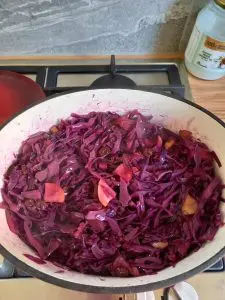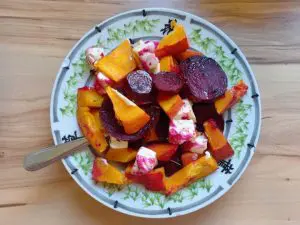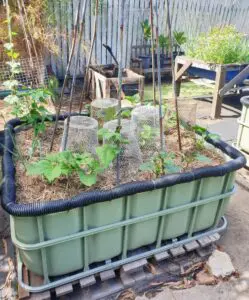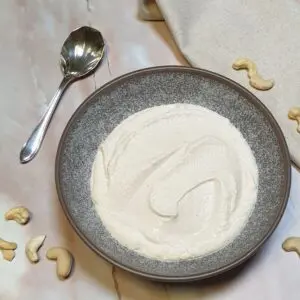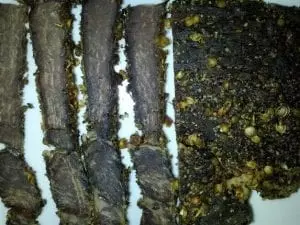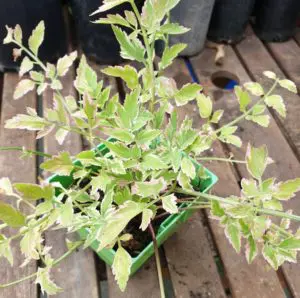So you’d like to grow some of your own food but you can’t be bothered digging the garden bed several times a year and managing annual vegetable crops. Well, then why not grow an edible perennial garden bed instead and have the best of both worlds – home grown produce with minimal work that looks awesome!
Although less maintenance is a pretty big bonus, there are several other advantages for creating an edible perennial garden bed such as: ornamental value, extended crop harvests, and good value food.
Perennial plants mean they last and grow more than just one year or season, unlike annual plants which only last the one season max. Perennials typically live for several years before dying or needing replenishment/replacing.
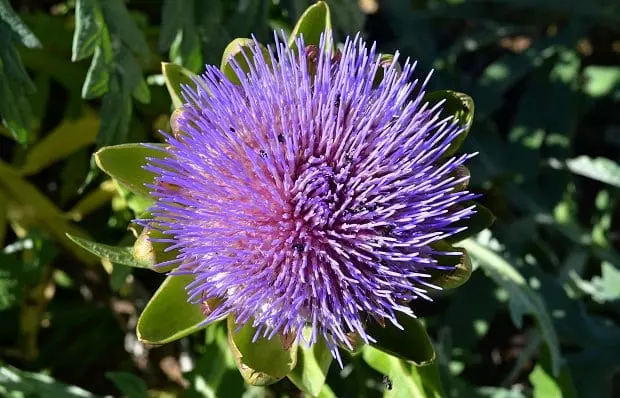
The beautiful globe artichoke flower (Image above – we always leave a few globes go to flower instead of eating them)
Ornamental value
A perennial food garden bed can blend into an existing ornamental non-food garden very effectively and easily. Indeed some gardeners refuse to “waste space” with non-food ornamental plants and grow food plants as ornamentals instead.
Perennial herbs and spices like parsley, ginger, turmeric, thyme, and oregano, look wonderful as ornamental edibles in the garden and if grown together complement each other perfectly with contrasting colours and textures. Thyme and oregano can crawl over rocks and hang over garden edges, parsley can fill voids, and chilli plants add colours, whilst ginger and turmeric can stand proudly in the background.
Let’s not forget the perennial vegetables either as some are strikingly beautiful, for example, globe artichokes have an amazing thistle flower and the soft fernlike foliage of asparagus (left to grow and open) is interesting and eye catching.
Extended crop harvests 
Most edible perennial plants offer produce over an extend period of time throughout the producing season. This is particularly useful for the home garden when a glut of produce is not normally desired and harvesting as needed is more convenient and prudent.
Often asparagus will produce spears sporadically for several months before going dormant through winter so it’s easy to harvest when needed straight from the garden rather than all at once just to go limp in the crisper. Madagascan beans will produce throughout the season and almost all year in the right climate with the massive beans holding in the pods on the vine for months to harvest at will.
Sweet potato is at its best through summer but can still be dug up at any time throughout the year and so can most perennial root food plants such as: ginger, Jerusalem artichoke, arrowroot, and turmeric, etc.
Capsicum and chillies will have an initial flush of flowers and subsequent fruit glut but after that they will continue to produce regular fruit for a long season and sometimes into winter. Purists might grow the larger capsicum varieties as an annual but for the person who isn’t a big fan of gardening these plants can be kept in-situ, roughly pruned over winter, for a reasonable harvest over several years.
Strawberries are not classed as a perennial, as such, but in the world of “Mark’s garden” I treat strawberries as I do any other perennial food crop because strawberries easily integrate with other perennials and act very much the same. Home grown strawberries have an extended harvest by nature (unlike commercially grown crops) and will often continue to produce fruit and runners for the next season all at the same time.
Good value food
In both a nutritional sense and also in a money savings way perennial crops are a good value food for the home gardener. Yes, generally all vegetables/fruit/herbs/spices grown at home whether annual or perennial are good for us nutritionally but considering the longevity of perennials it potentially means more use and the development of good habits wondering into the garden to select a few edibles for lunch or dinner.
Prices in store for many perennial foods crops are outrageous! Just a few plants or one packet of seed for a few dollars can potentially produce tons of produce, plus, once edible perennials are established there’s no need to ever buy those plants again because the existing plants can be easily propagated to make new ones.
How to prepare a perennial garden bed
Growing perennial food crops isn’t hard to do and they can potentially fit right into an existing garden bed as long as they can get enough light of course. Because I have an established vegetable garden, I prefer to use one or two beds set aside for perennial food crops only and that way I can group them together and leave them alone without having to work around my perennials to plant or harvest annuals.
Furthermore, perennial food plants tend to be larger than annual crops so planting annuals around perennials (or vice versa) can crowd growth and impede sunlight to young plants trying to get established – for fast growing annual crops the last thing they need is competition.

Preparing a perennial garden bed and planting artichoke seedlings with sweet potato (image above)
Site – Ensure the perennial garden bed is sited carefully because it’s a long term garden project and therefore it needs to be positioned exactly where you want it for best management, appearance, and convenience.
Most perennial food crops need full sunlight or at least sunlight for the majority of the day so if it is to be positioned in an established ornamental garden bed it should not be shaded by large trees or shrubs.
Soil – Prepare the site well by adding rotted manures, compost, some fertiliser (like blood & bone) and make sure the soil is good quality, is about 12 inches deep, has good drainage, but also retains moisture due to lots of organic matter present within the soil structure. Cover the soil with a thick mulch such as lucerne or crushed sugarcane so as to retain moisture and shelter roots from extremes.
Water – Edible perennial plants will need regular water and if it’s really a low maintenance food garden you’re after then a small DIY watering system is easy to do and well worth installing in the beginning to save hand watering every few days.

Tumeric in the foreground mixed with sweet potato and chillies in the background (image above)
Ongoing care – Although this particular type of food garden is low maintenance it still does require some work. Weeds will have to be kept under control and the garden bed should get an occasional sprinkle of fertiliser either commercial or home organic to keep the crops fed and growing healthy.
Some crops may require a supporting structure to climb or at least a stake to help the plant cope when heavily laden with fruit.
After the growing season, most perennial plants will need a tidy up prune (or a complete cut back depending on the plant); a re-mulching; and a bit of a spruce up with some extra manure/fertiliser to be ready again for the next growing season.
Propagation of perennial plants can also be done at the same time as the end of season tidy up by taking cuttings, dividing root balls, removing and replanting suckers, or digging up tubers to spread the plants out.
List of some excellent edible perennial plants
The following list are some of the best edible perennial plants I like to grow – feel free to add to this list in the comments section:
- Asparagus,
- Ginger,
- Chillies/capsicum,
- Turmeric,
- Artichokes,
- Jerusalem Artichokes,
- Madagascan bean,
- Sweet potato,
- Strawberries,
- Rhubarb, and
- Choko.

Tumeric flowers – not just an awesome Indian spice but a pretty plant too (image above)
Conclusion
See, it’s easy! A low maintenance, healthy producing, food garden is just one edible perennial garden bed away from good eating and money saving.
You can get inventive and make a food garden look ornamental with the right arrangement of edible perennials and at the same time supplement your grocery bill. Above all, you’ll have home grown, chemical free, fresh produce for several seasons off just one planting.
Feel free to leave a comment below or share this post. Also, we’d love it if you joined our self-sufficiency forum – naturally, it’s free…
Mark Valencia – Editor SSM
Look, and see the Earth through her eyes…

